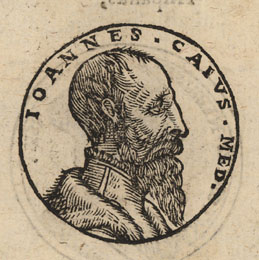| John Caius  Born: 6-Oct-1510 Born: 6-Oct-1510
Birthplace: Norwich, Norfolk, England
Died: 29-Jul-1573
Location of death: London, England
Cause of death: unspecified
Remains: Buried, Cambridge University
Gender: Male
Race or Ethnicity: White
Occupation: Doctor Nationality: England
Executive summary: Second founder of Gonville and Caius College English physician, and second founder of the present Gonville and Caius College, Cambridge, born at Norwich on the 6th of October 1510. He was admitted a student at what was then Gonville Hall, Cambridge, where he seems to have mainly studied divinity. After graduating in 1533, he visited Italy, where he studied under the celebrated Montanus and Andreas Vesalius at Padua; and in 1541 he took his degree in physic at Padua. In 1543 he visited several parts of Italy, Germany and France; and returned to England. He was a physician in London in 1547, and was admitted fellow of the College of Physicians, of which he was for many years president. In 1557, being then physician to Queen Mary I, he enlarged the foundation of his old college, changed the name from "Gonville Hall" to "Gonville and Caius College", and endowed it with several considerable estates, adding an entire new court at the expense of £1834. Of this college he accepted the mastership (24th of January 1558/9) on the death of Dr. Bacon, and held it until about a month before his death.
Caius was physician to King Edward VI, Queen Mary and Queen Elizabeth I. He returned to Cambridge from London for a few days in June 1573, about a month before his death, and resigned the mastership to Dr. Legge, a tutor at Jesus College. He died at his London House, in St. Bartholomew's, on the 29th of July 1573, but his body was brought to Cambridge, and buried in the chapel under the well-known monument which he had designed. Caius was a learned, active and benevolent man. In 1557 he erected a monument in St. Paul's to the memory of Linacre. In 1564 he obtained a grant for Gonville and Caius College to take the bodies of two malefactors annually for dissection; he was thus an important pioneer in advancing the science of anatomy. He probably devised, and certainly presented, the silver caduceus now in the possession of Caius College as part of its insignia; he first gave it to the College of Physicians, and afterwards presented the London College with another.
His works are: Annals of the College from 1555 to 1572; translation of several of Galen's works, printed at different times abroad. Hippocrates de Medicamentis, first discovered and published by Caius; also De Ratione Victus (1556). De Mendeti Methodo (1554). Account of the Sweating Sickness in England (1556). History of the University of Cambridge (1568). De Thermis Britannicis; but it is doubtful whether this work was ever printed. Of some Rare Plants and Animals (1570). De Canibus Britannicis (1570). De Pronunciatione Graecae et Latinae Linguae (1574); De Libris propriis (1570). He also wrote numerous other works which were never printed.
University: MA, University of Cambridge (1529)
Medical School: MD, University of Padua (1541)
Administrator: Gonville and Caius College, Cambridge University (re-founded, 1558)
Royal College of Physicians President (9 times)
Author of books:
A Boke or Conseille against the Disease commonly called the Sweate or Sweatyng Sicknesse (1552, nonfiction)
Of Some Rare Plants and Animals (1570)
De Canibus Britannicis (1570)
De Libris Propriis (1570)
De Pronunciatione Graecae et Latinae Linguae (1574)
Historia Cantabrigiensis Acadimae (1574, history)
Requires Flash 7+ and Javascript.
Do you know something we don't?
Submit a correction or make a comment about this profile
Copyright ©2019 Soylent Communications
|